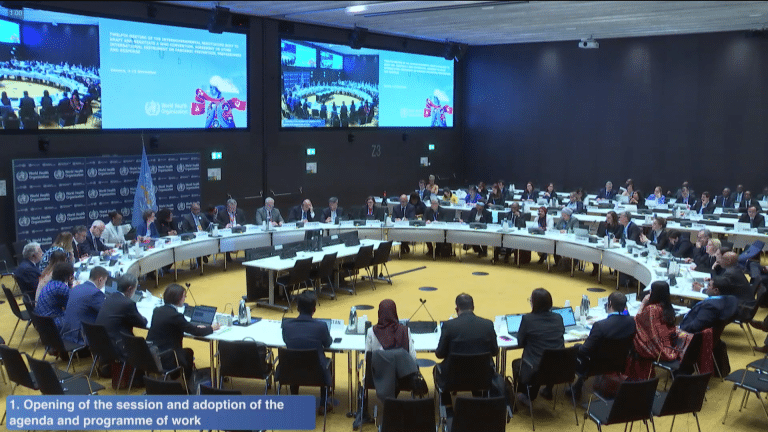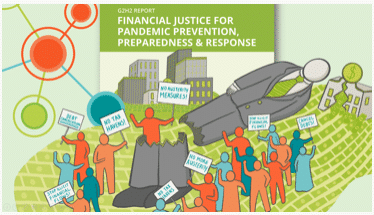Neglecting to do so jeopardizes more than only future pandemic PPR financing. Countries will need resources to implement the commitments made in the agreement. Without additional funding, implementation of new obligations will inevitably shift resources away from other parts of already overburdened health systems, including the provision of primary healthcare, care for infectious and non-communicable diseases and sexual and reproductive health services, especially in low- and middle-income countries.
At least three important developments in international finance (for health) are neglected in articles 19 and 20 of the current draft of the agreement. Addressing these, will be key to enabling all countries, especially low-and-middle income countries, to generate sufficient domestic public resources to invest in health systems and finance pandemic PPR.
Firstly, debt. Many countries are facing mounting debt burdens and increased debt interest payments which crowd out investment in basic social services like education and healthcare. Interest hikes in the global North have further increased the debt burden, with the steepest increases taking place in low-income countries. (See Financing Global Health 2023: The Future of Health Financing in the Post-Pandemic Era).
The failure of the global financial system to deliver promptly on the debt crisis is reducing life expectancy, worsening child mortality and cutting economic growth (source). While high-income countries have been neglecting their climate debt obligations, currently ongoing debt restructuring efforts fall short of solving the debt burdens that hinder many low- and middle-income countries to increase domestic resource mobilization. Yet, the suggested text addressing the debt problem which was included in earlier drafts of the pandemic agreement has completely disappeared from the latest draft, in spite of calls from the Africa Group to include such text.
In the version dated 13 March 2024, that was the basis for talks during the ninth meeting of the INB, article 20.1.c., said to “(c) promote, within relevant bilateral, regional and/or multilateral mechanisms, innovative financing measures, including but not limited to debt relief, based on transparent financial reprogramming plans for pandemic prevention, preparedness, response and recovery of health-system related actions, for affected countries whose debt payment might affect expenditures on pandemic prevention, preparedness and response, and in the case of pandemics, take measures for debt relief, including the suspension of debt servicing and debt cancellation;”
(No language on debt currently exists in the draft pandemic agreement. See here text submitted to the World Health Assembly in May 2024. Whether countries will open up the green text in Article 20 in November 2024 will remain to be seen.)
Secondly, there need to be opportunities for raising new resources through a more effective global tax system. All over the globe, tax collection, needed to sustain public budgets, is under pressure. While we witness an incredible accumulation of wealth, for transnational corporations and high net-worth individuals located mostly in high-income and some middle-income countries, governments worldwide are missing out on an enormous potential funding source by failing to tackle illicit financial flows, failing to address regressive taxation systems, and the unwillingness to effectively address tax havens and tax loopholes. Although this is relevant to countries in all income categories, it is especially crucial for low- and middle-income countries. With sufficient political will and international cooperation, the potential for increased domestic public resource mobilization is enormous, as clearly spelled out in this August edition of Geneva Health Files. [UN Tax Convention: A Structural Transformation for Financing Health.]
Thirdly, the role of Official Development Assistance (ODA) in global health financing. Overall, ODA – including for health – continues to struggle with many coordination, alignment and harmonization challenges, despite multiple initiatives for improvement that have been implemented over the last decades. Moreover, the quantity of ODA is going down with several traditional donor countries having announced or already implemented large cuts in their ODA budgets. The model proposed in the draft pandemic agreement relies strongly on voluntary, charity-like financing from donors. This underestimates alignment and coordination challenges, ignores the fact that ODA amounts are declining and that donors can change the focus of their aid according to their perceived change of priorities.
The only concrete measure included in article 20 of the draft agreement, is the establishment of a Coordinating Financial Mechanism. This mechanism aims to ‘promote sustainable financing for the implementation of this Agreement and the IHR’ and to ‘contribute to the availability of surge financing response […] particularly in developing country Parties’ (draft Agreement text dd. 20 September). To this end, the mechanism will conduct needs and gaps analysis, identify sources of financing, promote harmonization, coherence and coordination, provide support to State Parties to access available funding and leverage monetary voluntary contributions for organizations and other entities supporting pandemic PPR.
Some claim that including references to the global financial architecture is beyond the scope of the pandemic agreement. Such an argument ignores the Covid-19 experience, that left no doubt about the far-reaching social and economic losses. Avoiding repetition of that experience requires stepping up efforts to generate sufficient public funding for pandemic PPR and to reconstruct afterwards. Let’s not forget that a key reason for entering into negotiations on a pandemic agreement was to establish high-level governmental commitments on pandemic PPR that go across ministerial silos.
While a pandemic agreement cannot be expected to solve challenges in global finance, ignoring them would be a missed opportunity. The text can address the missing issues within the scope of the pandemic agreement given that it will be signed by member states, that are engaged in decision-making in other relevant institutions.
Whereas the pandemic agreement cannot be expected to provide solutions to the debt crisis, which are handled in other institutions, the text should: 1) acknowledge and refer to United Nations General Assembly resolution 68/304 “Towards the establishment of a multilateral legal framework for sovereign debt restructuring processes”; 2) bring back text from the 13 March version of the pandemic agreement referenced above.
While the debate on this issue is happening in the UN, at a minimum, negotiators on the pandemic agreement should support the UN process towards tackling illicit financial flows and working towards an effective and inclusive global tax system by including references to the relevant UN General Assembly resolutions: 1) A/RES/75/206, adopted on 29 December 2020, on the ‘Promotion of international cooperation to combat illicit financial flows and strengthen good practices on assets return to foster sustainable development‘ and 2) the two resolutions on “Promotion of inclusive and effective international tax cooperation at the United Nations adopted in 2022 (resolution 77/244) and 2023 (resolution 78/230)”.
The reliance on voluntary, charitable funding sources puts future pandemic PPR at risk, because of its volatility and unresolved coordination and alignment challenges. It is member states’ intention to have one Coordinating Financial Mechanism that will serve both the amended International Health Regulations (IHR) and the pandemic agreement. Yet it is still not clear how this will be implemented in practice.
The text on the Coordinating Financial Mechanism is greened in the draft pandemic agreement, indicating a consensus, although there are several important questions that remain to be sorted including its operationalization especially in relation to the IHR and pandemic agreement with their different scopes and nature. However, the important question of whether such a mechanism can be set up to successfully raise additional funding in a fair and sustainable way has not yet been addressed. This does not seem to feature on the agenda in the upcoming discussions.
The pandemic agreement will need to include strong language to ensure adequate and sufficient domestic resources for public health services and pandemic PPR, and a fair financing mechanism to fund regional and global common goods for health.
Many eyes are on the Pandemic Fund as the mechanism to fulfill this role, but there are questions about its fitness for purpose. The Pandemic Fund relies entirely on charitable donor funding, with its risks such as misalignment and volatility. The fund has a very limited scope of surveillance, laboratory systems and related human resource capacities, expansion of which depends on a successful resource mobilization. A successful resource mobilization, however, is questionable in the current challenging global funding landscape. Furthermore, the Pandemic Fund is hosted at the World Bank, the governance of which is dominated by high-income-countries. Even if governed independently, this may continue to be a reason for mistrust.
(Also see Center For Global Development: 2024–2025 Replenishment Traffic Jam Redux: Are Donors Getting into Gear?)
In addition to making references to UN processes working towards sustainable solutions to the debt crisis and enhancing effective global tax cooperation, negotiators can make the draft text more fit for purpose by removing weakening or harmful language. This includes replacing weak phrases such as ’encourage’ or ’promote’ with more actionable terms, like ‘ensure’ or ‘guarantee’. It also means providing clarity on how surge funding will be mobilized and being explicit about a preference for public funding. Then the agreement can result in a mechanism that works for, and answers to, the needs of low- and middle-income countries first and serves the equity goal of this pandemic agreement. The so-called ‘constructive ambiguity’ risks paving the way for inaction.
In conclusion, the pandemic agreement offers a rare opportunity to improve how the world responds to future health crises by ensuring sustainable fair financing of pandemic PPR. Tackling the crushing debt burdens faced by many low- and middle-income countries, raising new funds by reforming the global financial system to curb tax evasion, avoidance, and illicit financial flows, and commitments towards public financing of healthcare, are essential measures for equitable pandemic PPR.
To be truly prepared for the next global emergency, Parties must build a fairer, more resilient financial framework that enables all countries to prepare and respond swiftly and effectively to health crises, free from the constraints of financial fragility. Only through a comprehensive and inclusive approach can the pandemic agreement make a meaningful difference in realizing a more equitable, safer world.
Photo: Jeyaratnam Caniceus via Pixabay





